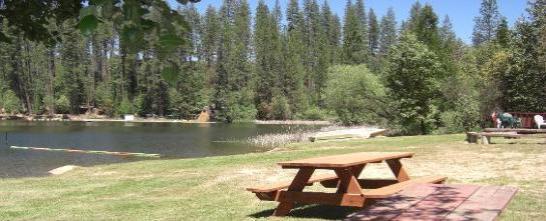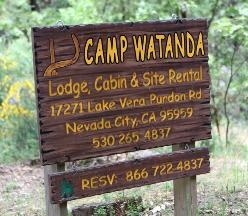
Waterfront and Picnic area
| HISTORY OF CAMP WATANDA Reservations & Fax: (707) 322-0945 |
| Consider Watanda Lodge or Cabin for your next family vacation or group event |

| Links for every thing you need before you leave What to bring Directions Fire Prevention Plan Policies & Procedures Waterfront Rules PETS Emergency Procedures |
| Watanda Lodge is located on a small 15-acre reservoir, built in 1896 and used to develop hydroelectric power for gold mining. Builders Tregidgo, John Martin, Romilus Colgate and other pioneers, gave their energy and risked their years height of the current dam which was built in 1928. In 1926 the Physical Education Department of Mills College, Oakland, offered courses in camp leadership which became an approved program of the Camp Directors Association. In 1927 William H Griffith, of Nevada City and Clarence J. Wetmore heard that Mills College in Oakland was looking for a summer camping site with waterfront property. Shortly after that, Mills College became the owner of the property surrounding Lake Vera, and the “Pioneer Camping for Girls” was born and established at Camp Gold Hollow. According to the deed recorded December 7, 1927, W. H. Griffith and F. M. Ray became the owners of the property known as Mills College Grove with the stipulation that it be used as camps for girls and states that it cannot be used for “saloons, gambling, dance halls, boys or mens camp or auto camp purposes; and that no malt, vinous, alcoholic or intoxicating liquors shall be manufactured". The major history of the area began in 1850 with Alfred T Jackson and his friend Pard Anderson who panned, flumed and rocked about $14,000 in gold per year from Rock Creek, other miners on Brush Creek took in $100 per day in gold. The land on which Camp Gold Hollow and Camp Watanda stands was mined by the 49er’s and Chinese, and then later re-mined. Damming Rock Creek and Brush Creek originally forming Lake Vera creating hydroelectric power used for mining. Several gullies dot the area were built by miners to increase the water pressure from the reservoir. In 1934 the Piedmont Girls Community Services Inc. of Alameda became the new owners of Camp Watanda in a division of the lake properties to various organizations serving girls. In 1939 the City of Alameda received its charter as a Camp Fire Council. In 1955, 44 acres was purchased by Camp Fire from the now defunct Piedmont Girls Community Services (Harris A. Ray) for $5,363.68. The estate of Judge Otis and Ester Scott Crooks, plus substantial gifts and proceeds from candy sales provided the funds to purchase the property and improvements and facilities to open the camp for the first time in 1956 to accommodate 30 campers and staff, for a total investment of $14,876.50. In that first year, the councilmen cleared trees for roads, built 3 living platforms or “kiosks”, a kitchen and dining platform, sanitary unit consisting of three flush toilets and three showers, beach for waterfront activities, and provided water and power to the site. Since that first year, the Health Hut has been added, a tool shed under the dining hall, a kiosk (1967) plus the counselor’s retreat and director’s cabin. About 1992 the kiosks were all rebuilt and named after donors and volunteers who worked on the platforms, Marley, Caseywood, Gallup, and Volunteers. During the 1970's Sunshine Charter school used this site and in the late 80’s and 90’s, a successful Day Camp was operated by Camp Fire for the local community. In 1998 the Alameda-Contra Costa Council of Camp Fire merged with the Columbia Park Boys and Girls Club, thereby taking ownership of Camp Watanda. The camp was too small for the needs of the Boys and Girls Club and sat dormant until privately purchased by John and Kathryn McNitt in December of 2002. |
